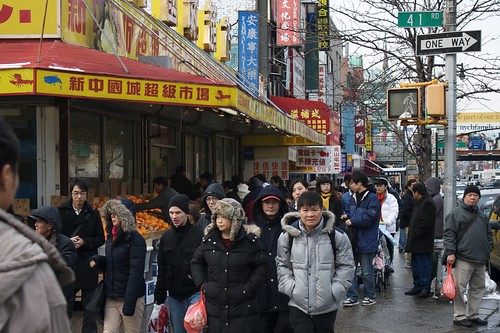Chinatown, for me is a mixed neighborhood just like any other. In Chinatown and beyond: The Chinese Population in Metropolitan New York, it states that a longitudinal study of the rate changing racial or ethnic composition of New York Chinatown cannot be done because of the lack of data, and it made me pause. It reminds me of the repressive governments that we used to and continue to live under. It also makes me have more hope for the future, in regards to how new and open minds can tackle the problem. That we can continue to try and rectify the mistakes of our past. In the past it was stated that the entire triangular space of Mott, Pell, and Doyers Streets including Chatham Square was basically for people from China. While many would characterize it as a self-imposed segregation, I would refer to it as a form of self-preservation from others. That same area is still the core of Chinatown but it’s starting to give way to a mixed neighborhood. Regardless of make up, Chinatown is probably more diverse than some states in the union.
Chinatown in New York provides recreational, financial, and other services for east Asians in the metropolitan area. My experience in Chinatown observing them and speaking to certain people have guided my belief that this ethnic enclave indoor for time to come make stronger decisions on what will happen in the future. However, Chinatown is changing as people with higher income, education, occupation tends to move near the city. Students also tend to live around institutions of higher education which are mostly uptown as opposed to downtown/ Lower East Side where Chinatown exists. As the younger generation tends to move away from Chinatown as it attempted to be a land of tradition as opposed to a land of the future where many Chinese Americans who become enveloped in the idea of Americanism begin to downplay the importance of some portions of their cultural heritage. I would assume that in the future the Chinese population will be dispersed over the metropolitan area.
Chinatown is a site that structures and also signifies the incorporation of Chinese immigrants inter-American society. As an urban area, New York’s Chinatown is familiar for its residential tenant buildings, loft manufacturing sweatshops, restaurants and street markets. The district is jammed vigorously into the southern pocket of Manhattan’s lower East side. The labor power of its industrious people have constructed an ethnic enclave that is the center of economic and social life for the Chinese population through out the New York City metropolitan area. To the people that live in Chinatown, it represents not just a productive arena but, from what I heard after speaking with a shopkeeper, a place of “cultural significance” and a quote “community of symbolic and sentimental value”.
For many who live outside of New York’s Chinatown, Chinatown has historically been inscribed as an overcrowded, dilapidated place, plagued with vice and social wretchedness. Personally, I tack that onto the anti-Oriental images of the late 19th-century. However, the end of ongoing durability of negative mental constructions is evident in a variety of ways. In many of the prime time television shows that are placed in New York, Chinatown has been viewed as an are hiding its crime, Implicating Chinatown as a place beset with social problems as well as undocumented immigrants. Even last year Fox News approached elderly Asian people and mocked them on television. After approaching many other Chinese Americans who lived in Chinatown for decades, I met a woman that I purposely kept out of my field notes. She spoke to me about how the US immigration policies in 1965 were the set of laws that provided the opportunity for American Chinatown to become family centered communities. New York’s Chinatown began to grow expansively in the nation’s largest Chinese American settlement, absorbing both legal and illegal migrants. I believe that the source of the changes from the United States government’s outlook on Chinese migrants is born from the alliance between the United States and China during World War II because it created a favorable diplomatic climate and Congress had rescinded the Chinese Exclusion Act in 1943(King).
Chinatown is a very singular place in the way that it created a home away from home for its people. After traveling through Chinatown and feeling like an outsider looking in, I believe that there’s so much that every culture has in common with another. While the foods and language may be different, the sense of family remains. My ideas about Chinatown weren’t challenged because I already knew that there was nothing wrong with it. Chinatown will continue to an area of immense importance to Chinese Americans regardless of gentrification and revamping(Sze). I am of the mind that Chinatown is just going to evolve, and that the next generation will care more for its protection.
Works Cited
- Yuan, D. Y. “Chinatown and Beyond: The Chinese Population in Metropolitan New York.” 27.4
(1966): 321-32. Web. 7 Apr. 2017. - Lin, Jan. Reconstructing Chinatown: ethnic enclaves and global change. Vol. 2. U of Minnesota Press, 1998.
- King, Haitung, and Frances B. Locke. “Chinese in the United States: A Century of Occupational Transition.” The International Migration Review, vol. 14, no. 1, 1980, pp. 15–42.,
- Sze, Lena. “Chinatown Then and Neoliberal Now: Gentrification Consciousness and the Ethnic-Specific Museum.” Identities, 17:5 (2010): 510-529, EBSCO. Web. 4 Apr. 2017.





